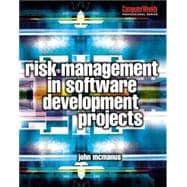
Note: Supplemental materials are not guaranteed with Rental or Used book purchases.
Purchase Benefits
Looking to rent a book? Rent Risk Management in Software Development Projects [ISBN: 9780750658676] for the semester, quarter, and short term or search our site for other textbooks by McManus. Renting a textbook can save you up to 90% from the cost of buying.
| Computer Weekly Professional Series | ix | ||||
| Preface | xi | ||||
| Acknowledgements | xii | ||||
| Book road map | xiii | ||||
| 1 The risk management process | 1 | (31) | |||
|
1 | (4) | |||
|
3 | (2) | |||
|
5 | (2) | |||
|
6 | (1) | |||
|
7 | (1) | |||
|
7 | (4) | |||
|
9 | (1) | |||
|
10 | (1) | |||
|
11 | (3) | |||
|
12 | (1) | |||
|
13 | (1) | |||
|
14 | (8) | |||
|
14 | (8) | |||
|
22 | (3) | |||
|
23 | (2) | |||
|
25 | (2) | |||
|
26 | (1) | |||
|
27 | (4) | |||
|
28 | (1) | |||
|
28 | (1) | |||
|
29 | (2) | |||
|
31 | (1) | |||
| 2 Discovering risk in software development projects | 32 | (30) | |||
|
32 | (1) | |||
|
32 | (6) | |||
|
33 | (1) | |||
|
34 | (4) | |||
|
38 | (4) | |||
|
40 | (2) | |||
|
42 | (5) | |||
|
43 | (1) | |||
|
43 | (2) | |||
|
45 | (1) | |||
|
46 | (1) | |||
|
46 | (1) | |||
|
47 | (2) | |||
|
48 | (1) | |||
|
48 | (1) | |||
|
49 | (2) | |||
|
51 | (4) | |||
|
51 | (4) | |||
|
55 | (6) | |||
|
56 | (1) | |||
|
57 | (1) | |||
|
58 | (1) | |||
|
59 | (1) | |||
|
59 | (2) | |||
|
61 | (1) | |||
| 3 Risk assessment in software development projects | 62 | (34) | |||
|
62 | (1) | |||
|
63 | (1) | |||
|
64 | (1) | |||
|
65 | (1) | |||
|
65 | (21) | |||
|
66 | (20) | |||
|
86 | (9) | |||
|
87 | (1) | |||
|
88 | (1) | |||
|
89 | (1) | |||
|
89 | (2) | |||
|
91 | (4) | |||
|
95 | (1) | |||
| 4 Planning risk mitigation strategies in software development projects | 96 | (26) | |||
|
96 | (1) | |||
|
97 | (2) | |||
|
97 | (2) | |||
|
99 | (1) | |||
|
99 | (6) | |||
|
99 | (2) | |||
|
101 | (1) | |||
|
102 | (2) | |||
|
104 | (1) | |||
|
105 | (5) | |||
|
107 | (3) | |||
|
110 | (6) | |||
|
111 | (1) | |||
|
112 | (2) | |||
|
114 | (1) | |||
|
114 | (2) | |||
|
116 | (5) | |||
|
116 | (1) | |||
|
117 | (1) | |||
|
118 | (1) | |||
|
119 | (1) | |||
|
120 | (1) | |||
|
121 | (1) | |||
| 5 Monitoring risk in software development projects | 122 | (18) | |||
|
122 | (1) | |||
|
123 | (4) | |||
|
124 | (1) | |||
|
125 | (1) | |||
|
125 | (1) | |||
|
126 | (1) | |||
|
126 | (1) | |||
|
127 | (5) | |||
|
128 | (1) | |||
|
129 | (1) | |||
|
130 | (1) | |||
|
131 | (1) | |||
|
132 | (4) | |||
|
133 | (1) | |||
|
134 | (2) | |||
|
136 | (3) | |||
|
138 | (1) | |||
|
139 | (1) | |||
| 6 Case study | 140 | (17) | |||
| Appendix A Glossary of risk terminology | 157 | (4) | |||
| Appendix B Risk management software tools | 161 | (2) | |||
| Subject reading | 163 | (4) | |||
| References | 167 | (2) | |||
| Index | 169 |
The New copy of this book will include any supplemental materials advertised. Please check the title of the book to determine if it should include any access cards, study guides, lab manuals, CDs, etc.
The Used, Rental and eBook copies of this book are not guaranteed to include any supplemental materials. Typically, only the book itself is included. This is true even if the title states it includes any access cards, study guides, lab manuals, CDs, etc.